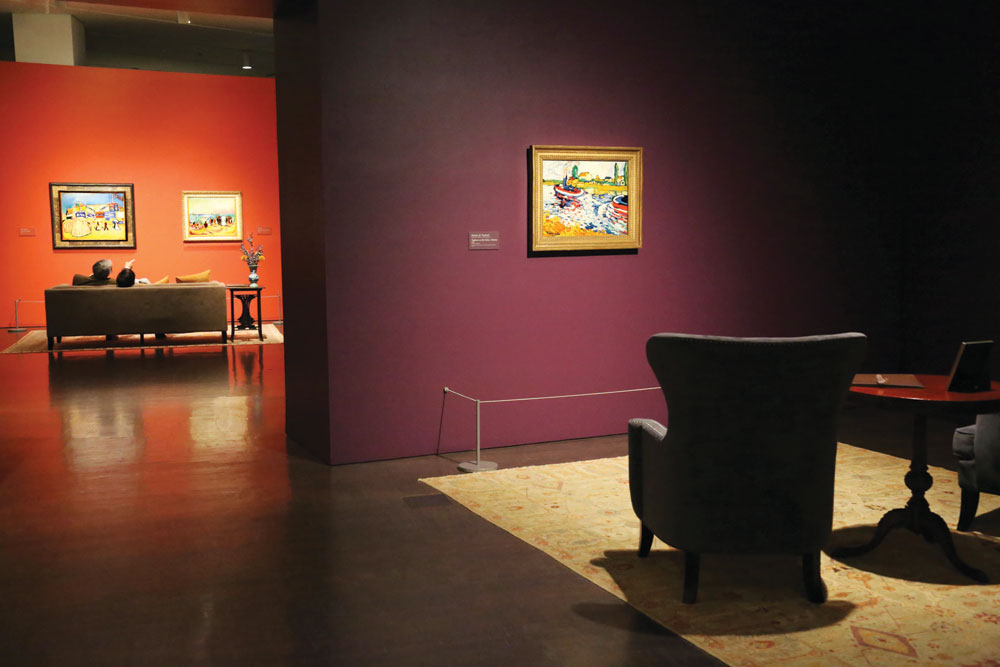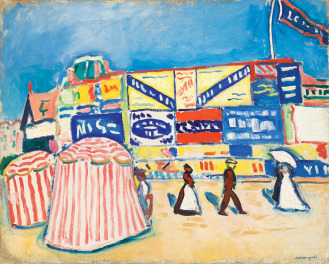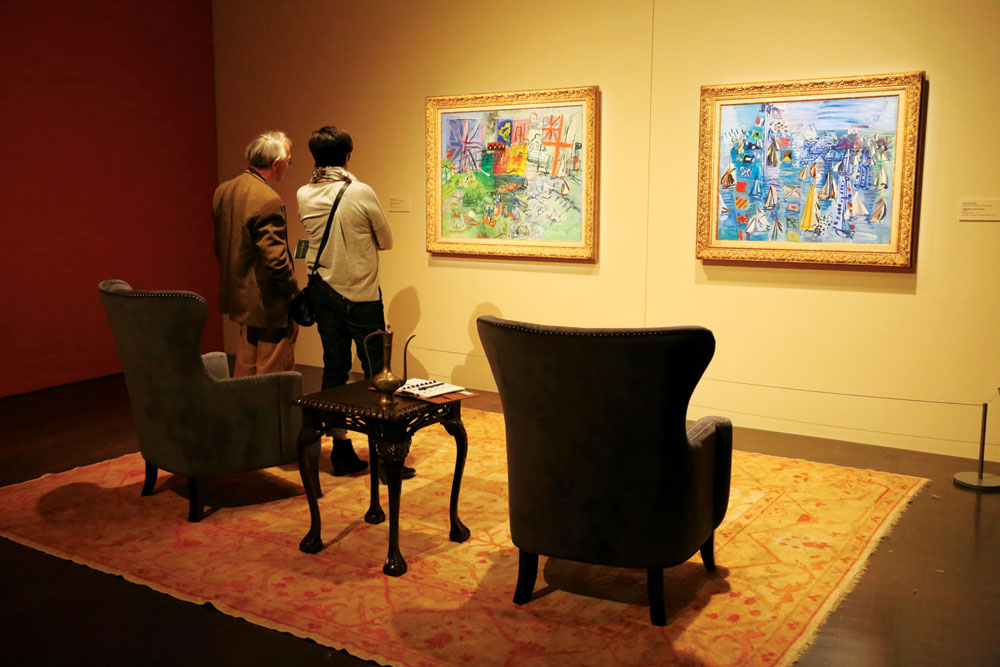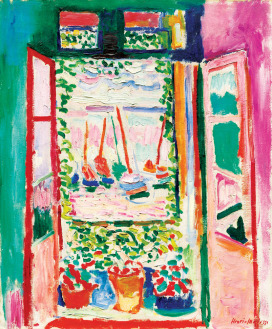
The exhibit was designed with comfortable seating areas throughout to invite viewers to spend time with the painting, becoming absorbed in the scene.

Albert Marquet’s “Posters at Trouville” can be seen in one of the boldly colored rooms of the “Matisse and Friends” exhibit at the Denver Art Museum. Matisse, Marquet and others were called “wild beasts” by French art critics of the early 1900’s for their bold use of color and daring lines.
Looking at the pleasing colors and understandable subject matter of the paintings in the Denver Art Museum’s latest exhibit, “Matisse and Friends: Selected Masterworks from the National Gallery of Art,” on display through Feb. 8, 2015, it’s hard to imagine that the artists were called “wild beasts” (“les fauves”) by Parisian art critics. Their bold use of colors and loose brush strokes were startling to the art world in the early 1900s. In their own bold fashion, the Denver Art Museum (DAM) has chosen to design “Matisse and Friends” in creative ways that make the most of the size and tone of the exhibition.
Fourteen paintings by Matisse and some of his contemporaries tell of a time when Impressionism “was becoming pedestrian, losing its power” because everyone was doing it, according to Dr. Christoph Heinrich, who holds the position of Frederick and Jan Mayer Director of the Denver Art Museum. “A new generation took it on, believing in the power of color and the immediacy of the scene.” He describes the paintings as ranking among the most important works in museums today, urging visitors to “Have an encounter with these exquisite paintings that you can have a dialogue with.”

“Regatta at Cowes” is by Raoul Dufy, a contemporary of Matisse’s and one of the artists featured in the exhibit. It is seen in detail, below, and in an exhibit room.

“Regatta at Cowes” is by Raoul Dufy
The exhibit is on loan from the National Gallery of Art in Washington, D.C., while they remodel. At the Gallery, the paintings are displayed on white walls but Danielle St. Peter, master teacher for modern and contemporary art at the DAM and the exhibit’s designer, placed them on walls colored purple, green and other colors found in each of the paintings. The effect accentuates the paintings and creates differentiated “rooms” the viewer can visit.
Multiple seating areas on ornate rugs provided by Shaver-Ramsey and props borrowed from the Denver Center Theatre Company invite museum-goers to linger at each painting. This design was inspired by a quote from Matisse painted on the entry wall of the exhibit:

Henri Matisse’s “Open Window, Collioure,” one of his most famous paintings, shows a view out of his French studio apartment. The audio tour encourages the viewer to fully explore and experience this, and each of the paintings, imagining smells, sounds and other sights.
“What I want is an art of purity and tranquility… so that all those who work with their brains… will look on it as something soothing, a kind of cerebral sedative, as relaxing in its way as a comfortable armchair.”
On the tables next to each seating area is a book of photographs, sketches and brief text about the artist whose painting is in that area.
In addition to bold-colored walls and opportunities to sit in front of each painting, St. Peter also created a different kind of audio tour experience. Usually, the tours offer historical references and explanations about the artist and that particular work. But St. Peter wanted to create more of a sensory experience. The viewer is encouraged to breathe deeply and relax;
visually explore the painting with eyes open and then eyes closed, from memory; to imagine being in the scene, taking note of what is heard, smelled, felt and seen. Although the audio devices are housed next to Matisse’s famous “Open Window, Collioure” painting, the recording is not specific to that work. The idea is for people to go through the audio exercises with multiple paintings in the exhibit to enjoy each on a deeper level.
Although “Matisse and Friends” doesn’t have activities specifically geared toward children, the smaller size of the exhibit, bright colors, understandable subject matter and opportunities to curl up to view each work of art makes the exhibit more family-friendly.
“Matisse and Friends” is on view in the Gallagher Family Gallery on level one of the Hamilton Building and is included in Denver Art Museum admission. www.denverartmuseum.org.



0 Comments